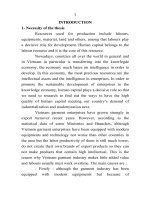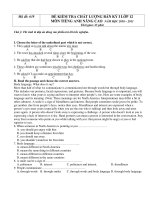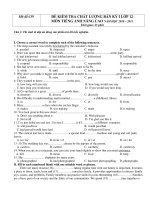Tieng Anh nang cao 2 CB4 [1]
Bạn đang xem bản rút gọn của tài liệu. Xem và tải ngay bản đầy đủ của tài liệu tại đây (156.53 KB, 9 trang )
BỘ GIÁO DỤC VÀ ðÀO TẠO
TRƯỜNG ðẠI HỌC MỞ TP.HCM
CỘNG HÒA XÃ HỘI CHỦ NGHĨA VIỆT NAM
ðộc lập – Tự do – Hạnh phúc
CHƯƠNG TRÌNH ðẠI HỌC / CAO ðẲNG
ðỀ CƯƠNG CHI TIẾT MÔN HỌC
1. THÔNG TIN CHUNG VỀ MÔN HỌC
1.1 Tên môn học:
Tiếng Anh nâng cao 2 (CB4)
1.2 Mã môn học:
GENG1404
1.3 Trình ñộ:
ðại học / Cao ñẳng
1.4 Ngành:
Cử nhân [không thuộc ngành Tiếng Anh]
1.5 Khoa phụ trách:
Khoa Ngoại ngữ
1.6 Số tín chỉ:
4 (tương ñương 70 tiết x 45 phút)
1.7 Yêu cầu ñối với môn học:
- ðiều kiện tiên quyết: Sinh viên ñã vượt qua môn Tiếng Anh Căn Bản A3
- Yêu cầu khác:
Không có
1.8 Yêu cầu ñối với sinh viên:
-
Tham dự lớp ít nhất 80% số tiết quy ñịnh (sinh viên vắng mặt 20% số tiết quy ñịnh sẽ bị
ñình chỉ thi).
-
Tự học các phần nội dung ñược chương trình và giáo viên quy ñịnh.
-
Tự trang bị giáo trình học tập chính.
-
Tham gia các hoạt ñộng lớp do giáo viên tổ chức.
2. MÔ TẢ MÔN HỌC VÀ MỤC TIÊU
2.1 TIẾNG ANH CĂN BẢN A4 là môn học thứ hai trong chương trình Tiếng Anh phổ quát bắt
buộc gồm 4 cấp ñộ (Tiếng Anh Căn Bản A1, A2 và Tiếng Anh Nâng Cao A3, A4) dành cho
sinh viên không thuộc khối ngành Tiếng Anh của trường ðại học Mở TP.Hồ Chí Minh. ðây
cũng là môn ñiều kiện ñể sinh viên có thể học tiếp môn Tiếng Anh Căn Bản A3.
Ngoài việc giúp sinh viên phát triển cân bằng cả bốn kỹ năng nghe-nói-ñọc-viết ở trình ñộ sơ
trung cấp (pre-intermediate), môn học còn giúp sinh viên từng bước phát triển các kỹ năng học
thuật và kỹ năng mềm, ñặc biệt là khả năng tự học và khả năng làm việc theo nhóm.
2.2 Sau khi hoàn tất chương trình, sinh viên có thể nghe hiểu nội dung chính các bài hội
thoại, ñọc hiểu các bài khóa ngắn ở mức ñộ sơ trung cấp, có thể giao tiếp về những chủ ñề
thông dụng hàng ngày, và có thể viết ñược ñoạn văn.
3. HỌC LIỆU
3.1 Giáo trình chính:
•
Cameron, S., Vargo, M. & Iannuzzi S. (2008). Hemisphere 2, 3, New York:
McGraw-Hill ESL/ELT.
1
•
Johannen, K. (2008).
ESL/ETT.
Hemisphere 2, 3 Workbook.
New York:
McGraw-Hill
3.2 Một số tài liệu tham khảo:
•
Richards, J. C. (1997). New Interchange One & Two, Cambridge:
Cambridge University Press.
4. ðÁNH GIÁ KẾT QUẢ HỌC TẬP
4.1 Hình thức và tỷ lệ ñánh giáù
Nội dung
Các hoạt ñộng
tại lớp
Thi cuối khóa
Hình thức ñánh giá
Tỷ lệ
Ghi chú
Hiện diện, phát biểu
trong lớp (10%)
10% ñiểm hiện diện bao gồm cả việc
sinh viên tham gia vào các hoạt ñộng
trong lớp.
Kiểm tra giữa kỳ (10%)
Hình thức và thời gian kiểm tra do
giáo viên ñứng lớp quyết ñịnh và
thông báo trước cho sinh viên.
Thi vấn ñáp (10%)
Các chủ ñề thi vấn ñáp nằm trong
chương trình học, thời gian thi do giáo
viên ñứng lớp quyết ñịnh và thông báo
trước cho sinh viên.
Thi nghe + Thi viết
ðề thi chung cho tất cả các lớp A2
30%
70%
4.2 ðịnh dạng ñề thi cuối khóa
Dạng câu hỏi
Số câu hỏi
Thang ñiểm (10 ñiểm)
Section A: Listening Comprehension
(Multiple Choice, True/False, Gap-Filling)
15
03
Section B: Reading Comprehension
(Multiple Choice, Word-Definition, Matching)
15
03
khoảng 20
04
Section C: Grammar & Writing
(Gap-Filling, Sentence Rearrangement/
Writing a Paragraph)
4.3 Thang ñiểm ñánh giáù
ðiểm hoạt ñộng tại lớp và ñiểm thi cuối khóa ñều ñược ñánh giá theo thang ñiểm 10 (không làm
tròn) và sau ñó ñược tính phần trăm theo quy ñịnh trên.
2
6
6
6
2
6
(period)
Time
Suggested resources
future
Unit 12:
Topic: MEMORIES
Conversation Strategy:
Reading: Understanding internal definitions,
3
Unit 11:
Topic: MAKING A DIFFERENCE
Conversation Strategy: Discussing opinions
Reading: Making predictions, paraphrasing
Listening: Listening for specific information,
Distinguishing between facts and opinions
Grammar: The present perfect versus the simple past
Writing: using details to support an opinion
Writing: summarizing
Conversation Strategy: Keeping in touch
Unit 10:
Reading: Previewing a reading, making inferences
1. Topic: STAY IN TOUCH
Listening: identifying problems and solution, sequences
Grammar: The passive verb form in the present, past and
Expansion (Units 7-9)
Conversation Strategy: Asking for and giving Unit 9 (Book 2):
clarifications
Topic: MAKEOVERS
Reading: Skimming for main ideas, summarizing
Listening: Listening for specific information, comparing
and contrasting
Grammar: Present unreal conditional (the 2nd conditional)
Writing: Comparing two things, organizing information
with a Venn diagram
Learning objectives
5. KẾ HOẠCH VÀ NỘI DUNG GIẢNG DẠY
n
Expansion is for self-study;
teachers only check answers and
cover the listening section in class.
.
Notes
6
6
6
2
Writing: Writing descriptive paragraphs,
Writing a description of difficulties and challenges
Expansion (Units 10-12)
4
Conversation Strategy: Commiserating
Unit 3:
Reading: Using title and headings to aid comprehension, Topic: RELATING
making inferences
Listening: Listening to confirm first impression,
Conversation Strategy: Asking for additional information Unit 2
Reading: Skimming for the main ideas, sequencing
Topic: SCENTS
Listening: Listening for gist, identifying examples to
support your answer
Grammar: Review the simple present, present continuous,
simple past, and past continuous
Writing: Writing topic sentences
Unit 1 (Book 3):
Conversation Strategy: Asking for and giving advice
Topic: THE OTHER SIDE OF
Reading: Scanning for specific information, reading for FAME
answers to Wh- questions
Listening: Listening for specific information, comparing
and contrasting
Grammar: Questions in the simple present and simple past
Quantifiers: no, some, a lot of, a whole lot of,
most of (the), a few,
many, a little
Writing: Mastering the parts of a paragraph
perfect
Identifying causes and effects
Listening: Listening for gist, listening for specific information
Grammar: The present perfect continuous versus the present
(6) teachers introduce basic
theories in class and assign
students homework.
(2), (6), (7) & (9) are for self-study.
(6) teachers introduce basic
theories in class and assign
students homework.
(2), (6), (7) & (9) are for self-study.
Expansion is for self-study;
teachers only check answers and
cover the listening section in class.
6
6
6
2
Expansion (Units 1-3)
(6) teachers introduce basic
theories in class and assign
students homework.
(2), (6), (7) & (9) are for self-study.
(2), (6), (7) & (9) are for selfstudy.(6) teachers introduce basic
theories in class and assign
students homework.
Expansion is for self-study;
teachers only check answers and
cover the listening section in class.
5
Conversation Strategy: Asking if someone has time to Unit 6:
(2), (6), (7) & (9) are for self-study.
talk
Topic: THINGS THAT SCARE
(6) teachers introduce basic
Reading: Scanning to see what information is included in a US
theories in class and assign
text,
Conversation Strategy: Asking and answering personal Unit 5:
questions
Topic: CREATING AN IMAGE
Reading: Understanding parenthetical information,
Reading for specific information
Listening: Listening for specific information
Listening to distinguish between fact and
opinion
Grammar: Simple present for future
Writing: Supporting your writing with graphs and charts
Conversation Strategy: Correcting a misinterpretation
Unit 4:
Reading: Skimming for the main ideas, understanding Topic: DIGGING
what pronouns refer to
Listening: Anticipating topic and language from context
and visual aids
Getting basic information without understanding
every word
Grammar: Dependent and independent clauses
Writing: Using descriptive language
Gerunds and infinitives: differences in
meanings following stop, remember, forget
Writing: Using graphic organizers for planning
predictions
Grammar:
Using prior knowledge and impressions to make
4
2
Assessment
Identifying words that indicate purpose
Listening: Identifying correct information
Recognizing supporting example
Grammar: Quantifiers: a few, few, a little, little
Writing: Using punctuation to convey tone or emotion
6
Expansion (Units 4-6)
End-of-course oral test
Expansion is for self-study;
teachers only check answers and
cover the listening section in class.
students homework.
6. PHỤ LỤC
•
Các câu hỏi thi vấn ñáp (Topics for A2 Oral Examination)
•
Các chủ ñề viết ñoạn văn (Topics for A2 Paragraph Writing)
7. GIẢNG VIÊN BIÊN SOẠN
•
Họ và tên: Lê Hồ Hương
•
Chức danh, học hàm, học vị: Giảng viên – Thạc sỹ
•
Thời gian, ñịa ñiểm làm việc: ðH Mở Tp. Hồ Chí Minh, 97 Võ Văn Tần, Q3
•
ðịa chỉ liên hệ: ðH Mở Tp. Hồ Chí Minh
•
ðiện thoại, email: 3 8237 328 –
Ban giám hiệu
Trưởng phòng QLðT
7
Trưởng khoa
TOPICS FOR A4 ORAL EXAMINATION
1. What’s your secret ambition?
What are some of the obstacles in your way?
What would happen if you achieved your goal? How would your life change?
2. How do you think the internet is changing different parts of the world?
Name some efects it has on the world and/or your home town.
3.
THE END
8
TOPICS FOR A4 PARAGRAPH WRITING
1. Write a paragraph about a landmark in your city.
2. Write a paragraph about a restaurant that you like.
3. Write a paragraph about a restaurant that you don’t like.
4. Write a paragraph about a trip that you took in the past.
5. Write a paragraph about the smartest person that you know.
6. Write a paragraph about the greatest singer / athlete / musician / actor / writer
in the world (in your opinion).
7. Write a paragraph to describe a place that is getting trendy. It can be a city,
a restaurant, a store, or a country.
8. Write a paragraph to describe a room that you like in your house.
9. Write a paragraph about an urban legend.
10. Write a paragraph about a city or a town that you like.
THE END
9









